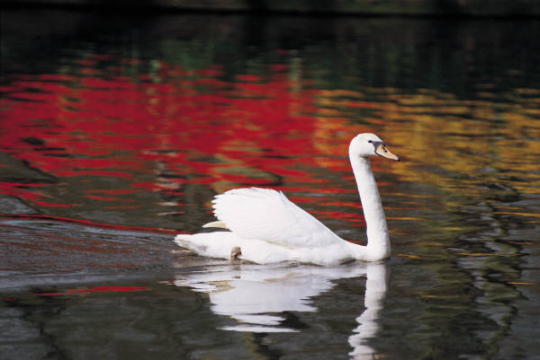Blog
Swans Set to Return to Buckhorn
 Many of you shared our heartbreak at losing Teller and his mates. But we are delighted to announce that two new swans will be joining us as soon as it is warm enough for them to be flown from Chicago.
Many of you shared our heartbreak at losing Teller and his mates. But we are delighted to announce that two new swans will be joining us as soon as it is warm enough for them to be flown from Chicago.
Mute swans are at their most vulnerable during the nesting season. While our swans had a nesting box in a safe location in the pond, they insisted on nesting on the shore where they could become prey to coyotes and bears. When defending a nest they do not swim to safety. We knew that swans are happiest in pairs, and we could not face losing more swans and their cygnets. What we recently learned, however, is that same-sex swans form strong partnerships with each other. Therefor our new swans are two brothers who, our vendor assures us, are already bonded. Minimal sibling rivalry here!
Guests sometimes ask us why the swans are called “mute” swans. The answer is that they are much less vocal than other swans. That does not mean they are silent thought! Mute swans make a variety of sounds that could be called grunting, snorting, whistling, chirping, squawking, and hissing.
Swans are beautiful and graceful birds. In England, swans are considered royal birds and all swans in open waters belong to the crown. For many centuries, mute swans were raised for food with individual birds being marked on their feet or beaks to indicated ownership. These marks were registered with the Crown and a Royal Swanherd was appointed. Any birds not marked became property of the crown, thus leading them to be called royal birds. Mute swans were introduced to North America in the late 19th century. In the United States, swans were nearing extinction as recently as the 1930’s. Thankfully preservation efforts have allowed their population to grow again.
If you are not familiar with swans, here are some fast facts to “pre-introduce” you to our new guests!
• Mute swan fossils 6,000 years old have been found in post-glacial peat beds in Great Britain.
• Adult mute swans typically range from 55 to 63 inches long with a 79 to 94 inch wingspan.
• Mute swans are the second largest waterfowl after the trumpeter swan.
• The mute swan is one of the heaviest flying birds with a weight range of 20 to 32 pounds.
• They feed on a wide range of vegetation, both underwater plants and land plants.
• The swans’ threat display is called “busking”. A busking swan curves its neck back and half-raises his wings. Swans also use this pose to “windsurf” across bodies of water.
• The fairy tale “The Ugly Duckling” by Hans Christian Anderson is the story of a cygnet who is perceived to be ugly by his fellow fowl. Eventually he matures into a graceful swan, the most beautiful bird of all.
• In the ballet “Swan Lake”, the main character and her companions are turned into swans by a wicked spell.
• The mute swans in the moat at the Bishops Palace at Wells Cathedral in England have been trained to ring bells to beg for food. Swans have been trained there in this way for centuries.
The swans will have a beautiful home. Over the winter we have installed a fountain to help the pond stay healthy and to provide soothing sound; removed fallen trees and brush; and installed many new plantings. The plantings include evergreens to screen the pond from Buckhorn Road, flowering trees and bushes, and perennials to provide season-long color. Our spring-fed pond will be one of your favorite places on our property!
Watch future newsletters and ou to be among the first to know when our swans arrive! We also will provide instructions for accessing our “Swan Cam” so you can keep abreast of their activities from wherever you happen to be.




Gatlinburg Weather
Click for weather forecast